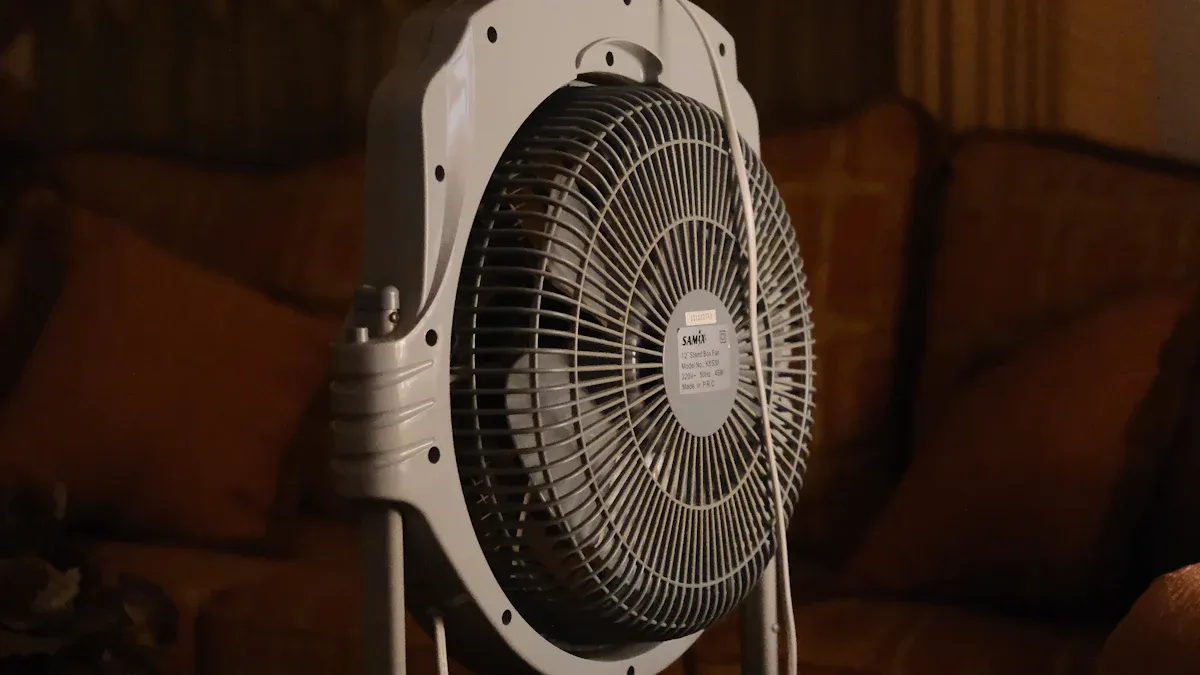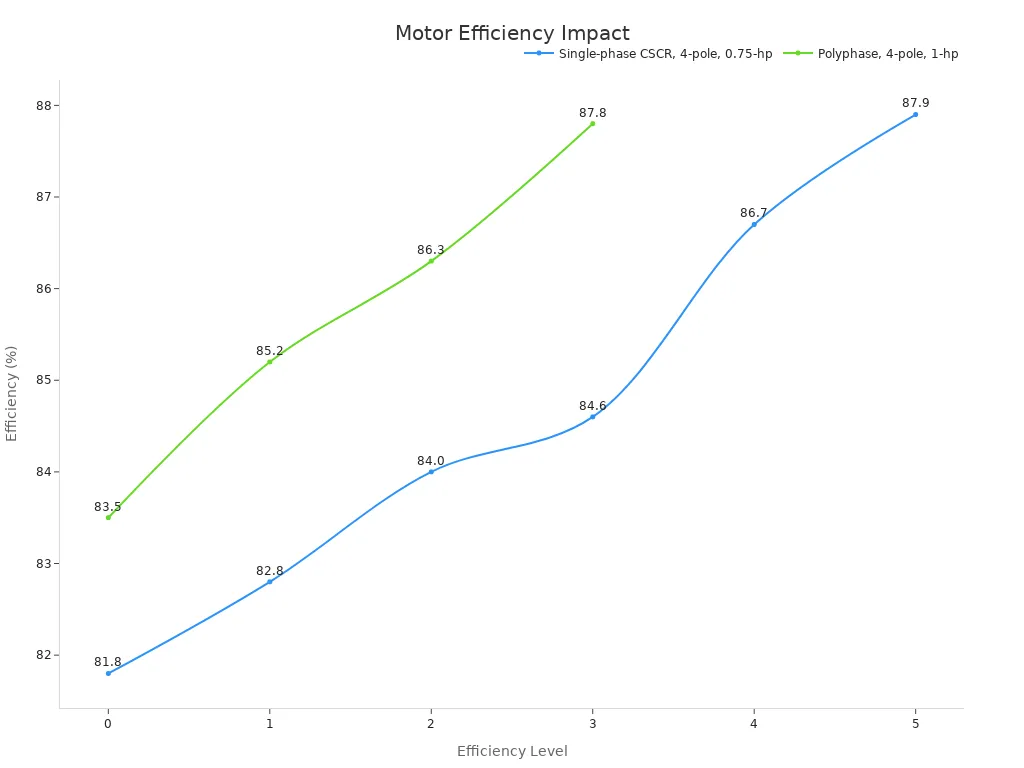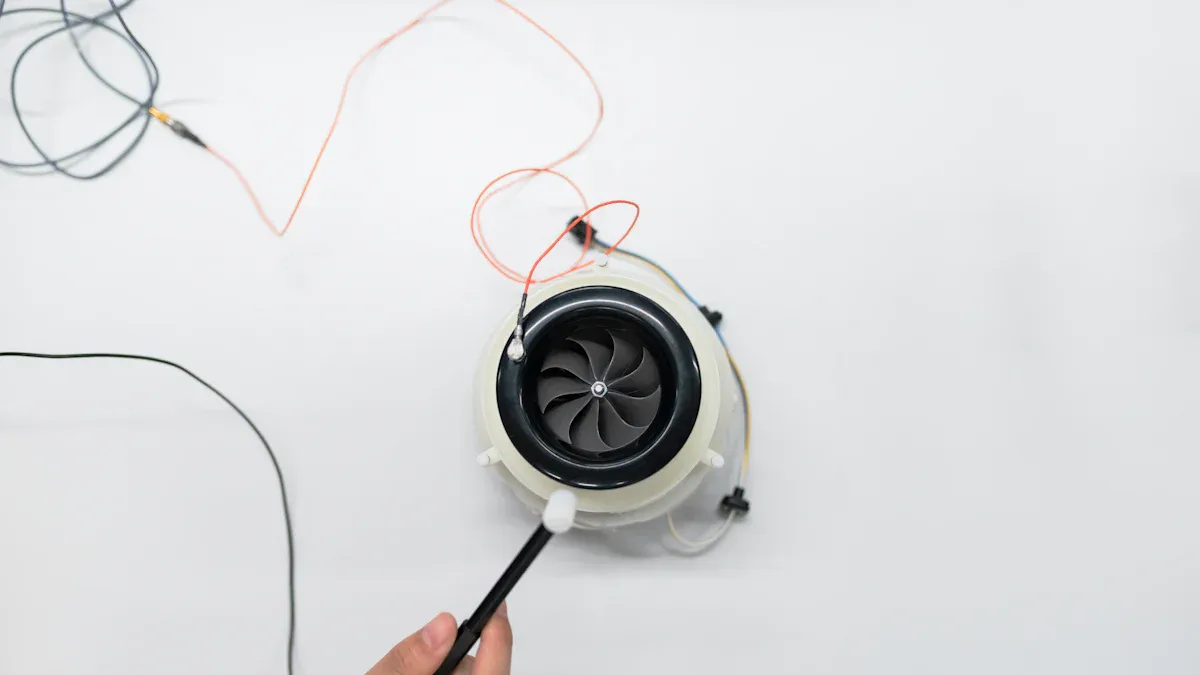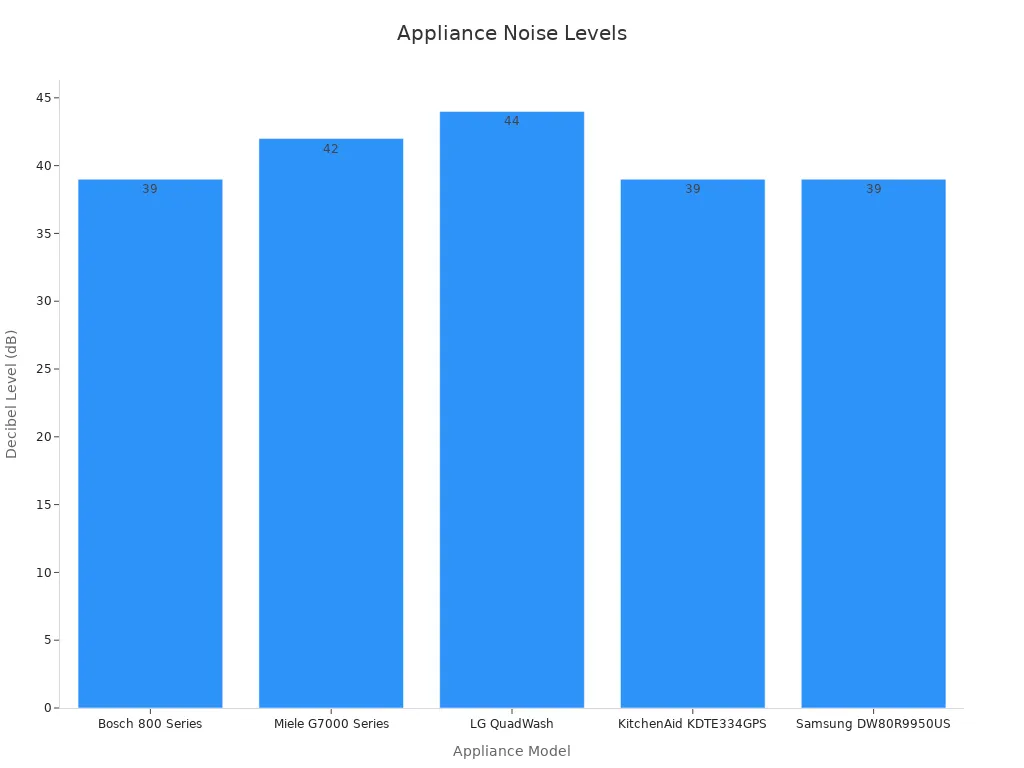Choosing the Right Small Electrical Motor for Household Appliances

Choosing the right small electrical motor for your home is important. It can change how your appliance works and how much energy it uses. When you pick a small electrical motor, you should think about power, torque, speed, efficiency, noise, and safety. A higher-efficiency small electrical motor can help you save money on your energy bill. The table below shows that even a small change in efficiency can save you money:
Motor Type and Class | Efficiency Level (EL) | Efficiency (%) |
|---|---|---|
Single-phase CSCR, 4-pole, 0.75-hp | 0 | 81.8 |
Single-phase CSCR, 4-pole, 0.75-hp | 5 | 87.9 |
Polyphase, 4-pole, 1-hp | 0 | 83.5 |
Polyphase, 4-pole, 1-hp | 3 | 87.8 |

Picking the right small electrical motor helps your wallet and the planet. You don’t need to be an expert to make a good choice.
Key Takeaways
Make sure the motor’s power, torque, and speed fit your appliance. This helps it work well and use less energy.
Pick the right motor type. AC motors last longer and need less care. Brushless motors are quieter and last longer than brushed ones.
Check the motor’s size and the space in your appliance before you buy. This makes sure it fits and works well.
Find motors with safety features and certifications. These help protect your home and keep your appliance safe.
Take care of your motor often. Clean it, check the wires, and add oil to parts. This helps it last longer and stops problems.
Appliance Needs
When you choose a small electric motor for your appliance, you need to match the motor to the job. Each appliance has its own needs. You should look at power, torque, speed, and the space where the motor will fit. These steps help you make a smart choice.
Power & Torque
Power tells you how much work the motor can do. Torque shows how much force the motor can turn. You need to know both for your appliance to work well. For example, a blender needs a motor with high torque to crush ice. A fan needs less torque but steady power to move air.
Tip: Check the appliance manual or label for power (watts) and torque (Newton-meters or ounce-inches). This information helps you pick the right motor.
Several studies show that looking at your appliance’s needs helps you save energy and money. Reviews and life cycle assessments show that matching the motor’s power and torque to the job can lower energy use and reduce environmental impact. If you use a motor that is too strong, you waste energy. If it is too weak, your appliance may not work or could break.
Speed (RPM)
Speed, measured in revolutions per minute (RPM), tells you how fast the motor turns. Different appliances need different speeds. A washing machine needs a motor with variable speed for washing and spinning. A vacuum cleaner needs a high-speed motor to create strong suction.
Common Appliance Speeds:
Ceiling fan: 200–350 RPM
Blender: 10,000–20,000 RPM
Washing machine: 500–1,200 RPM
Surveys from many countries show that using the right speed for each job saves electricity. Motors that run too fast or too slow for the task waste energy. Some appliances use variable speed drives to adjust the motor speed. This helps you use only the energy you need.
Size & Space
You must check the space inside your appliance before you buy a motor. Electric motor size matters. If the motor is too big, it will not fit. If it is too small, it may not have enough power. Proper sizing means you choose a motor that fits well and works right.
Note: Always measure the space for the motor. Leave room for wires and cooling.
Here are some examples of common household appliances and their typical motor needs:
Appliance | Power (Watts) | Torque (Nm) | Speed (RPM) | Motor Size (cm) |
|---|---|---|---|---|
Blender | 300–800 | 0.5–1.5 | 10,000–20,000 | 8–12 |
Washing Machine | 400–800 | 2–5 | 500–1,200 | 15–20 |
Vacuum Cleaner | 500–1,200 | 1–2 | 20,000–30,000 | 10–15 |
Ceiling Fan | 60–80 | 0.2–0.5 | 200–350 | 10–15 |
Case studies show that you should balance efficiency, size, and environmental impact. Some high-efficiency motors use rare earth materials, which can affect the environment. You need to weigh the benefits of energy savings against the cost and impact of the motor.
Choosing the right small electric motor for your appliance means looking at power, torque, speed, and space. When you follow these steps, you help your appliance work better and last longer.
Motor Types & Specs
When you pick a motor for your appliance, you should know the main types and what they do. Each type is good for certain jobs. This part will help you look at the choices and find the best one for you.
AC vs. DC
Most household appliances use either AC or DC motors. AC stands for alternating current. DC stands for direct current. Each type works best in different ways.
Specification Aspect | AC Motors | DC Motors |
|---|---|---|
Efficiency | High at constant speeds; best for steady loads | High across a wide range of speeds; good for changing speeds |
Maintenance | Low; no brushes or commutators | Higher; brushes and commutators wear out |
Lifespan | Long; fewer parts to wear out | Shorter; brushes need replacement |
Speed Control | Needs extra equipment for precise control | Easy; change voltage to adjust speed |
Load Handling | Good for steady loads | Great for frequent starts, stops, and changes |
Noise Immunity | More affected by electrical noise | Less affected; simpler design |
AC motors are good if your appliance runs at the same speed, like a ceiling fan or washing machine. DC motors are better if you need to change speeds a lot, like in a cordless drill or toy car. DC motors let you control speed better, but you will have to replace brushes after some time.
Tip: If you want a motor that lasts longer and needs less care, AC motors are a smart pick for most home uses.
Brushed vs. Brushless
Motors can be brushed or brushless. This choice changes how long the motor lasts and how much work it needs.
Feature | Brushed Motors | Brushless Motors |
|---|---|---|
Lifespan | 1,000–3,000 hours | 5,000–20,000 hours |
Maintenance | Needs brush replacement | Minimal maintenance |
Durability | Less durable | More durable |
Noise | Louder | Quieter |
Brushed motors have brushes that touch moving parts. These brushes wear out and must be replaced. Brushless motors do not have brushes, so they last longer and are quieter. You can find brushless motors in new appliances like fancy fans, vacuum cleaners, and some kitchen tools.
Brushless motors can last up to ten times longer than brushed ones.
Brushed motors cost less at first but need more repairs later.
Brushless motors need almost no care, but if they break, you might need a new one.
If you want a small electric motor that lasts longer and is quiet, choose a brushless motor.
Permanent Magnet Motors
Permanent magnet motors use strong magnets to work better. These motors are popular in new appliances because they save energy and are quiet.
Performance Metric | Permanent Magnet Motors vs Conventional Motors |
|---|---|
Full speed performance improvement | |
Half speed performance improvement | 7–12% higher performance |
Efficiency at one-sixth speed | About 24% higher efficiency |
Energy consumption reduction in appliances | 22–42% less energy used |
Household energy cost savings | About 30% savings |
Efficiency advantage over induction motors | Up to 15% more efficient |
You will see permanent magnet motors in energy-saving appliances like refrigerators, washing machines, and air conditioners. These motors help you pay less for energy and are better for the environment. They cost more at first, but you save money later.
Note: Permanent magnet motors are smaller and lighter than other types, so they fit well in small appliances.
Voltage & Frequency
You need to make sure the motor’s voltage and frequency match your home’s power. Most homes use 110–120V at 60Hz in North America or 220–240V at 50Hz in other places. Using the wrong voltage or frequency can make the motor get too hot, lose power, or break faster.
Voltage/Frequency | Effect on Motor Performance |
|---|---|
Too high voltage | Causes overheating and shortens lifespan |
Too low voltage | Reduces power and may stall the motor |
Wrong frequency | Changes speed and can damage the motor |
Always check the label on your appliance and motor. Make sure the numbers match your home’s power. If you use a motor with the wrong numbers, it might not work right or could be unsafe.
Tip: If you are not sure about voltage or frequency, ask an expert before you buy or put in a small electrical motor.
Small Electrical Motor Efficiency

Energy Use
You want your appliance to use less power but still work well. To check how efficient a small electrical motor is, look at some important numbers. These are power factor, motor efficiency, input power, and output power. The table below explains what these mean and why they matter:
Metric | Definition/Formula | Why It Matters |
|---|---|---|
Power Factor | Ratio of real power to apparent power (cosφ) | Shows how well the motor uses power |
Motor Efficiency | (Output Power / Input Power) × 100% | Tells you how much energy is wasted |
Input Power | Voltage × Current | Total energy the motor uses |
Output Power | Torque × Speed × 2π/60 | Work the motor does |
Reactive Power | I × U × sinφ | Power lost in the system |
Energy Consumption Ratio | Compares to standards or benchmarks | Helps you see improvements |
You can use tools like wattmeters and torque sensors to check these numbers. Many new small electric motors, like permanent magnet types, can be 90% efficient or more. If you pick a motor that saves energy, you spend less money and help the earth.
Noise Level
Noise can make your home less comfortable. Many new appliances use quiet motors to keep noise down. You should check the decibel (dB) rating before you choose a motor. The chart below shows how loud some common appliances are:

Most quiet dishwashers and washers are about 39–44 dB. Motors with direct drive and good insulation make less noise. If you live in an apartment, a quiet motor helps you not bother your neighbors. You can also make motors quieter by installing them right and keeping them in good shape.
Tip: Pick appliances with sound-absorbing parts and new motor technology for better performance and less noise.
Material Quality
Good material quality helps your motor last longer and work better. High-quality motors use special alloys like Hiperco50® to make them strong and cool. These materials help the motor stay cool and work hard without breaking. Makers test motors for heat, strength, and core loss to make sure they work well in real life.
You should also look for certifications. Find labels like IEC 60034, UL, CE, and ISO 9001. These show the motor is safe and made well. Good materials and certifications mean your small electrical motor will work well and last a long time.
Note: Always ask for certificates and test reports when you buy a new motor.
Choose the Right Motor for Safety & Installation
Mounting & Wiring
When you put in a small electrical motor, you must be careful. The motor should sit flat and not move around. If the base is not even, the motor can shake and wear out fast. Many motors break because they are not set up right or are forced into place. You should check if the feet of the motor are uneven before you tighten the bolts. Fix any problems so the motor sits flat.
Wiring is also very important. Use the right size wire and follow the maker’s wiring diagram. If wires are loose or wrong, the motor can get too hot or even catch fire. After you finish, check all the wires again. Make sure the motor spins the right way. Watch for shaking to find problems early.
Tip: If you install the motor right and check it often, you can stop most motor problems.
Protective Features
You should pick motors with good safety features to protect your home. Good motors have built-in guards against getting too hot, dust, and water. Many motors have special marks that show they meet safety rules. These marks mean the motor is safe to use in tough places.
Certification/Standard Type | Examples/Details |
|---|---|
North American Standards | UL 1004 Series, CAN/CSA C22.2, NFPA 496 |
International Standards | IEC 60034-5, IEC 60079-15, IEC 80079-36 |
Explosion Protection | IECEx, ATEX, UKCA, INMETRO, CCOE (India) |
Energy Efficiency Testing | U.S. DOE, Natural Resources Canada, IEEE 112-2004 |
Product Types Certified | Appliance Motors, Permanent Magnet Motors, Electronically Commutated Motors |
Motors with these marks have passed tests for fire, blasts, and electric safety. Always look for these marks when you buy a motor. This helps keep your appliance and home safe.
Maintenance
To keep your motor working well, you need to care for it often. Check and test your motor at least two times a year. Clean the motor and look for dust or dirt. Make sure all parts move without sticking. Some tools can help you find problems before the motor breaks.
Look at the bearings and add oil if needed. Most bearings last a long time.
Clean the motor and the area around it to stop dust from building up.
Watch the voltage and current to find problems early.
Change your care plan if your home is very wet, dusty, or hot.
Write down all the work you do on the motor. This helps you see if there are any patterns. Taking care of your motor helps it last longer and keeps your appliance safe.
Cost & Longevity
Price vs. Performance
When you pick a small electrical motor, you want good value. You should think about both the price and how well it works. Experts use life-cycle cost and payback period to compare motors. These help you see the total cost, not just the price. They include buying, installing, and running the motor over time. The table below shows what is included in these checks:
Aspect | Description |
|---|---|
Metrics Used | Life-Cycle Cost (LCC), Payback Period (PBP) |
Inputs to Analysis | Equipment cost, energy use, electricity price, maintenance, lifetime |
Methodology | Simulations to include different user habits and prices |
Efficiency Levels | Baseline, intermediate, high-efficiency designs |
Cost Approaches | Price surveys, teardowns, catalogs |
Energy Price Data | Based on reports and regional differences |
Maintenance & Repair Costs | Usually small for small motors |
Equipment Lifetime | Based on industry data |
Payback Period Definition | Time to recover extra cost through energy savings |
Conclusions | Compares higher purchase cost to energy savings and payback time |
Tip: A high-efficiency motor might cost more at first, but it can save you money later because it uses less energy.
Durability
You want your motor to last a long time. How long it lasts depends on the materials, design, and how you use it. Newer motors use better materials and electronics. These changes help motors handle more heat and last longer. In electric vehicles, experts look at torque density, control, and reliability to see how long a motor will last. Good control and strong parts help your motor work well and need fewer repairs.
Motors with advanced electronics last longer.
Better cooling and strong bearings help motors last.
Taking care of your motor and using it right stops early problems.
Portability
If you need to move your appliance, think about the motor’s size and weight. Smaller and lighter motors make appliances easier to carry and store. Many new motors are compact and use lighter materials. This makes them great for portable things like hand mixers or cordless tools.
Lightweight motors are easier to put in.
Small motors fit in tight places.
Portable appliances help you save space at home.
Note: Always check the weight and size before you buy a motor for something you want to move.
You can pick the right small electrical motor if you follow some easy steps:
Make sure the motor’s power, torque, and speed fit what your appliance needs.
Look at the size, type, and safety parts before you buy it.
Use a list to compare motors and ask an expert if you are not sure.
Take care of your motor often. Studies show that checking bearings and testing insulation helps your motor last longer and stops sudden problems.
Even simple checks and regular care can stop failures and help your appliances work well for many years.
FAQ
How do you know which motor size fits your appliance?
Measure the space inside your appliance. Check the motor’s length, width, and height. Compare these to your available space. Always leave extra room for wires and cooling. If you feel unsure, ask the manufacturer for size details.
What should you do if your motor gets hot quickly?
Turn off the appliance right away. Check for dust or blocked vents. Clean the area around the motor. Make sure the motor matches your appliance’s voltage. If the problem continues, contact a professional for help.
Can you replace a brushed motor with a brushless one?
Yes, you can often upgrade to a brushless motor. Check if the new motor matches your appliance’s voltage, size, and mounting style. Brushless motors last longer and run quieter. You may need to adjust wiring or use a new controller.
How often should you maintain your small electrical motor?
You should check and clean your motor every six months. Look for dust, loose wires, or worn parts. Lubricate bearings if needed. Write down each check in a log. Regular care helps your motor last longer.
What safety features should you look for in a small motor?
Look for motors with thermal protection, dust covers, and water resistance. Check for safety certifications like UL or CE. These features help prevent fires and electric shocks. Always read the labels before you buy.
See Also
Choosing The Best Mini DC Motors For Industrial Use
Five Key Steps To Choose The Ideal Small Vibrator Motor
Guide To Picking The Perfect Vibrating Motor For Projects
Get Custom Micro DC Motors from
INEED Motors!
Leading Brand in Vibration Motor Manufacturing Industry
